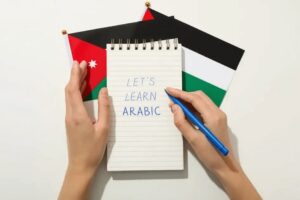
The Origin and History of the Arabic Language
The Arabic language is one of the world’s most enduring and culturally influential tongues. Spoken by over 400 million people across the Middle East and North Africa, it’s not only a tool of communication but also a carrier of history, science, art, and religion.
Its journey—spanning over 3,000 years—has witnessed immense political shifts, religious revolutions, and scientific golden ages. Understanding the history of the Arabic language gives learners context for why it functions as it does today—especially the gap between Classical Arabic, Modern Standard Arabic, and everyday dialects.
Table of Contents
ToggleThe Historical Timeline of Arabic
1- Proto-Arabic (1500–500 BCE)
Long before Arabic as we know it existed, the ancestors of the language emerged from the Central Semitic language group. Proto-Arabic shares deep roots with Hebrew, Akkadian, and Aramaic, characterized by triliteral roots (three-consonant bases for word construction).
Proto-Arabic speakers left Safaitic and Thamudic inscriptions across the Arabian Peninsula.
These scripts are the earliest linguistic footprints of what would become the Arabic family.
2- Old Arabic (500 BCE – 7th Century CE)
By the 6th century CE, distinct forms of Arabic were spoken across the Arabian Peninsula. Though regional, these dialects shared recognizable grammar and vocabulary.
Nabatean Arabic influenced the Arabic script, transitioning from Aramaic to early Arabic calligraphy.
Poets like Imru’ al-Qays defined the formal language through rich oral traditions long before the Quran was revealed.
3- Classical Arabic (7th–9th Century CE)
The revelation of the Quran in the 7th century AD marked a dramatic standardization of Arabic:
- Classical Arabic was preserved in Quranic grammar, morphology, and spelling.
- Scholars such as Sibawayh compiled grammar rules that are still studied today.
- Arabic expanded rapidly with the Islamic Empire, spreading to North Africa, the Levant, Persia, and Spain.
This is the Arabic found in early Islamic science, literature, and religious texts—still widely studied and respected.
4- Middle Arabic (10th–18th Century CE)
As Arabic spread and mingled with local cultures, a transitional form emerged:
Used in commerce, administration, and literature, Middle Arabic blended Classical Arabic with dialectal speech.
It shows early signs of grammar simplification, paving the way for today’s dialects.
This period saw the rise of regional Arabic dictionaries, glossaries, and the beginnings of mutual unintelligibility between dialects.
Key Branches of Arabic Today
Arabic today splits into three broad categories:
- Classical Arabic – Quranic and literary Arabic.
- Modern Standard Arabic (MSA) – Formal Arabic used in media, education, and official communication.
Arabic Dialects – Regional spoken languages such as:
- Egyptian Arabic
- Levantine (Jordan, Lebanon, Syria, Palestine)
- Gulf Arabic
- Maghrebi (Morocco, Algeria, Tunisia)
These dialects often differ so greatly that native speakers experience mutual unintelligibility.
5 Fascinating Linguistic Evolutions
1. Sound Shifts
Arabic has experienced regional phonological changes that distinguish dialects from Classical Arabic and even from one another:
- ق (qaf), originally a voiceless uvular stop, is pronounced as Glottal stop (ʔ) in urban Levantine (e.g., “ʔalb” instead of “qalb” for heart)
- G (hard g) in Egyptian and some Gulf dialects, Preserved as Q in Classical Arabic and some Bedouin varieties
- ج (jeem) shifts from “j” as in “jam” to “g” in Egypt and parts of Sudan and Yemen.
These shifts reflect the phonetic fluidity of Arabic’s spoken forms and their adaptation to local sounds.
2. Vocabulary Changes
Arabic has undergone both preservation and borrowing:
Ancient Survival:
Words like “نور” (light), “ليل” (night), and “قلب” (heart) have remained unchanged from Quranic Arabic to today’s dialects.
Many Classical metaphors and idioms persist in formal writing and poetry.
Modern Borrowing:
- Arabic integrates foreign words easily, especially for modern inventions:
- “تلفاز” (television), “هاتف” (phone), and “كمبيوتر” (computer) are either adapted or phonetically borrowed.
- In Moroccan Arabic, for example, French words like “gare” (train station) and “voiture” (car) are used daily.
This blend shows Arabic’s linguistic flexibility across centuries.
3. Grammar Simplification
Over time, Arabic grammar has become more streamlined in its spoken forms:
Classical Arabic uses full case endings (iʿrāb), complex dual forms, and verb-subject-object order.
Modern dialects:
- Drop final short vowels (e.g., “كتب” instead of “كَتَبَ”)
- Use simplified verb conjugations
- Shift to subject-verb-object or even verb-subject-object patterns depending on region
This simplification makes spoken Arabic more accessible, though it adds complexity when shifting between dialects and MSA.
4. Script Developments
The Arabic script evolved from Nabatean Aramaic, taking its final form between the 4th–7th centuries CE.
- Kufic script: angular, monumental, used in early Qur’ans and architecture.
- Naskh script: cursive and easier to read—became the standard for printing and manuscripts.
- Ruqʿah and Diwani: decorative scripts used in calligraphy and Ottoman bureaucracy.
Modern digital fonts (like Simplified Arabic and Arial Arabic) continue this evolution, balancing tradition with legibility.
5. Digital Age Adaptations
The rise of smartphones and global communication has shaped new Arabic usage forms:
Arabizi (Arabic + English letters and numbers):
- Used in texting and social media to represent Arabic words using Latin script and numbers (e.g., “7abibi” = حبيبي).
- Emoji integration and abbreviations are now common in both dialect and MSA conversations online.
- Platforms like Twitter and TikTok foster blended expressions, where MSA and dialect merge informally for wider audience reach.
This digital evolution proves that the Arabic language continues to evolve, adapting to new technologies without losing its historical core.
AlBaher’s Historical Arabic Programs
At AlBaher Arabic Language Center, learners explore Arabic beyond the textbook.
“Arabic in the Wild” Program: Students learn Arabic through real-world experiences in markets, cafés, and historical sites.
Quranic Arabic Workshop: Explore Classical Arabic with attention to Quranic grammar, rhetoric, and vocabulary roots.
Dialect History Tours: Guided cultural trips across Jordan explore how Arabic dialects evolved and why they matter today.
Final Thought
From the 6th century AD oral traditions to 21st-century texting apps, the Arabic language continues to evolve while preserving its ancient soul. Understanding its history is key to mastering its modern forms. At AlBaher Arabic Language Center, we bring that history to life—through speech, script, and immersive cultural learning.
You may also like

Learn Arabic for Beginners: From Letters to Real Conversations


